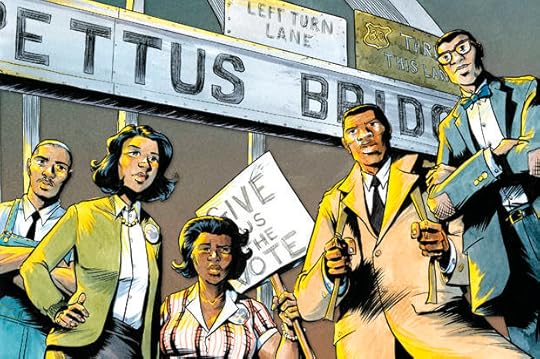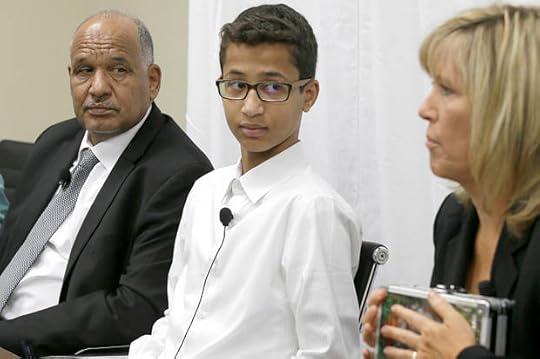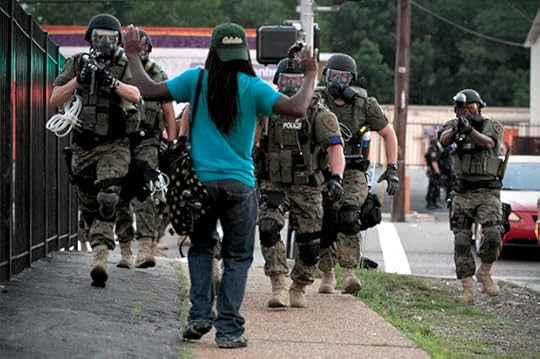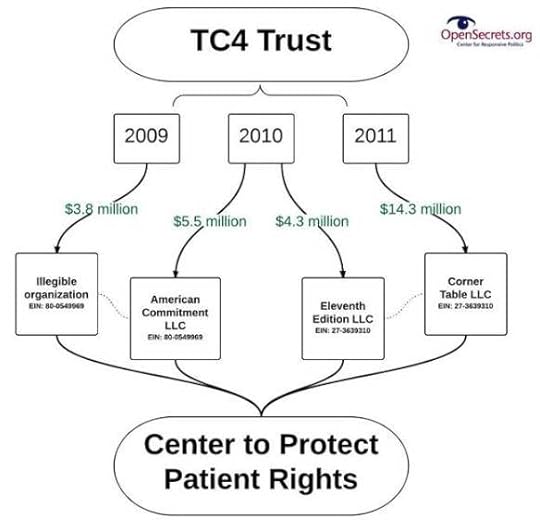Helen H. Moore's Blog, page 694
August 9, 2016
Poll: Melania Trump would be least popular first lady since ……… Hillary

(Credit: AP Photo/J. Scott Applewhite)
Melania Trump, current wife of GOP presidential candidate Donald, could become the least popular first lady since Hillary Clinton, according to a recent Washington Post/ABC News poll.
39% of all adults surveyed said they viewed Barron’s mom unfavorably (compared to 33% favorably and 28% no opinion). Among registered voters surveyed, Melania boasts a congruous 37% un/favorable split.
As New York Magazine notes, “To find a spouse less positively viewed than Melania, you’d have to go back to January 1996 — and a presidential spouse named Hillary Clinton.”
The polling also found Democratic nominee Hillary Clinton’s lead increasing over her Republican opponent following both parties’ conventions. Among a random sampling of 1,002 voting-age adults, 50% preferred Clinton to Trump’s 42%, with a margin of error +/- 3.5%.
Find detailed results here.
(h/t New York Magazine)
August 8, 2016
John Lewis marches on: “Our struggle is a struggle to redeem the soul of America”

(Credit: Top Shelf Productions)
“How could our quest for human dignity spawn such evil?”
That’s a question posed by Congressman John Lewis on an early page of his new graphic memoir, “March: Book Three.” The year is 1963. The place: Birmingham, Alabama. The Civil Rights Movement is in full swing, and so is the violent counter-movement to snuff it out. The 16th Street Baptist Church has been bombed, claiming the lives of four little girls. And this was not an isolated incident. When describing the events of 1964, Lewis and his co-authors — the acclaimed graphic novelist, Nate Powell, and Lewis’s Digital Director and Policy Advisor, Andrew Aydin — write, “In Mississippi that summer we suffered more than 1,000 arrests, 80 beatings, 35 shootings, 35 church burnings, and 30 bombings.” On another page, Lewis, who was then the chairman of the Student Nonviolent Coordinating Committee (SNCC), says, “The news from Washington seemed so far away – we were in the middle of a war.”
Book Three is the violent, yet triumphant, capstone to a trilogy that serves two narrative purposes. On one level, it is an autobiography of a man who, as the book’s promo copy notes, rose from an “Alabama sharecropper’s farm to the halls of Congress, from a segregated schoolroom to the 1963 March on Washington, and from receiving beatings from state troopers to receiving the Medal of Freedom from the first African-American president.”
But the books are also a sweeping visual history of the Civil Rights Movement offering stories of Rosa Parks, Malcolm X, Martin Luther King Jr., and countless other characters, including Alabama Governor George Wallace, who, in a speech depicted in 2015’s “March: Book Two,” calls for “Segregation today, segregation tomorrow, segregation forever.” By the end of Book Three — and after countless scenes of beatings, arrests, murders, and ongoing, defiant protests and sit-ins — the Voting Rights Act has been signed, and Lewis is handed one of the ceremonial pens by President Lyndon Johnson. “It was the last day of the movement as I knew it,” Lewis says. In another scene, at President Obama’s inauguration in 2009, the newly sworn president hugs a teary-eyed Lewis and hands him a note that reads, “Because of, you, John.”
The March trilogy is being heralded as one of the most important graphic novels released in some time. It has received a coveted Eisner Award. It is being assigned in New York City public schools. Its artwork was recently described by one awestruck Washington Post reviewer as “profoundly virtuosic art that measures up to the content of the characters, and the import of the story.”
It is, in short, a book that should be at top of anyone’s reading list. Salon recently spoke via phone with the three authors.
What do you guys hope readers take away from this story?
Congressman John Lewis: It is our hope that when people read “March” — Book One, Book Two, and Book Three — that they will understand that another generation of people, especially young people, were deeply inspired by the work of Rosa Parks, Martin Luther King Jr. and many others. So they studied the way of peace, the way of love, the way of nonviolence, and they stood up and they spoke up and they spoke out in a nonviolent fashion to change America forever. And [as a result] our country is a better country and we are better people. [These activists] didn’t become bitter or hostile. They didn’t hate. They understood what Dr. King said when he said, “Hate is too heavy a burden to bear.”
Although this is a trilogy about nonviolent action, these are very violent books. Time and again, readers see awful violence and bloodshed. Are there any readers who are too young for the books?
Andrew Aydin: It’s important to realize that the series actually grows with the reader. “March: Book One” is a great introduction for kids as young as eight or nine years old. But then they grow with the reader. Book Two is bigger, Book Three is even bigger. And they grow more violent and more confrontational. So, much like people started off, and everyone read “The Sorcerer’s Stone” for Harry Potter, Book One is meant to be that book that allows everybody to get introduced, and then each child can read [the others] whenever they’re ready.
What do you think is gained by telling this story in a graphic novel format? What power is achieved that perhaps can’t be conveyed with just words or even with moving pictures?
Nate Powell: I know “accessibility” is a term that’s kind of thrown around wantonly today, especially with talking about visual media. But I think that the strength of comics [is how they] really allow you to transcend those last barriers between a reader absorbing the information of an experience, and a reader being able to project themselves into the [experience of the] people about whom they’re reading.
I knew a bunch of this stuff to a certain extent before I started working on “March.” But it wasn’t until I really read [Lewis’s memoir] “Walking With the Wind,” and I was doing my own research, and then I was getting research from Andrew and Congressman Lewis …along the way, that it wasn’t until the drawing board, really processing all of this and putting it out in a way that I could absorb, that this really was something that at its core was being pushed along by 20-year-olds and 25-year-olds.
And so drawing that as a 31- or a 35-year-old, and [also] being a dad and having a four-year-old daughter and watching her grow into this world she’ll inherit, being able to envision her as a 15-year old or a 20-year-old with a sense of justice and fairness — these are concepts which are very clear to me as a dad and as a visual artist. So I think being able to identify with young people and…their capacity to change the world and shake things up. I think that’s the greatest strength.
Aydin: We’re [also] trying to talk to a generation who grew up on the Internet. They’re digital natives, and, essentially, they speak through sequential storytelling. I mean, a good comic-book panel is not that much different than a meme. And so if we’re going to speak to them, we have to do it in their language. And that’s why it’s important that we use comics.
Speaking of comics, Andrew, I’m fascinated by the connection between these “March” books and a comic book from the 1950s about Martin Luther King. Can you talk a bit about that connection?
Aydin: Sure. “March” was inspired by “Martin Luther King and the Montgomery Story.” I actually first heard about that comic from John Lewis, who told me that it played an important role in the movement. And so once he told me about that, it made me start thinking, “Well, why doesn’t John Lewis write his own comic book?” We knew “The Montgomery Story” was about the Montgomery bus boycott, but so much happened afterwards and I‘d never seen anything [about] that [portrayed] in comics form. I’d barely heard about it in school.
So, from that point, actually I went on to write my graduate thesis on the [“Montgomery Story”] comic book itself. It was the first long-form history that was ever written about it. And it’s how I found out Martin Luther King actually helped edit “Martin Luther King and the Montgomery Story.” We found the letter with his edits. And it made me feel some kinship with Dr. King, actually — imagining him poring over a comic book script. But really the thing that was so interesting to us was how they used the comic book from December of 1957 to the mid-1960s. It ended up inspiring some of the earliest acts of civil disobedience of the movement. And so many of the young people read it. So what my graduate thesis ended up becoming was a proof of concept for us that a comic book could work in that way.
Representative Lewis, I follow you on social media, and you’re often posting photographs and stories from the Civil Rights era with the hashtag “#goodtrouble.” For folks who aren’t familiar with that concept, what is “good trouble?”
Lewis: When I was growing up in rural Alabama, as a young child, about 50 miles from Montgomery, and we would visit the little town of Troy, or visit Montgomery or Tuskegee, I would see the signs that said, “WHITE MEN — COLORED MEN,” “WHITE WOMEN — COLORED WOMEN.” You’d go downtown on a Saturday afternoon to the theaters, and all of us little black children had to go upstairs to the balcony, and all of the little white children went downstairs to the first floor. And I would come home and say to my mother and father and my grandparents, “Why?” “Why this?” “Why that?” And they would just tell me, “That’s just the way it is! Don’t get in the way. Don’t cause trouble.”
I met Rosa Parks when I was 17. I met Dr. King when I was 18. These two individuals inspired me to find a way to get in the way, to get in trouble. So I got in good trouble, necessary trouble. And “March” is saying to young people and people not so young, “Going through history, you can get in trouble. But let it be good trouble, necessary trouble, to change things.” When you see something, and it’s not right, not fair, not just, you have to do something about it.
Scenes of President Obama’s first inauguration in 2009 are interspersed throughout these books. They form a kind of backbone for the story. Why did you choose that event for that purpose?
Aydin: We chose to frame “March” around the inauguration of Barack Obama because it was such an important moment in the story of the Civil Rights Movement. It wasn’t the fulfillment of Dr. King’s dream, but it was a major down payment. And I think all too often when we tell the story of the movement, people say, “Well, what’s changed?” And the Congressman often says, “Well, come walk in my shoes and I will show you change.” And that’s what we were trying to do. We were trying to show that you should be hopeful, you should be optimistic, but you have to be consistent and persistent, because it’s not the struggle of a day, a week, a month, or a year. It’s the struggle of a lifetime. And so you’re going to have to put in 40 or 50 years to reach that high-water mark.
But I think also there’s another part of this that’s coming into play, which is that there will be a generation of students who go to school and never know what it’s like to live in a world where we haven’t had an African American president. And so part of it is putting down a marker to remind them what was given, what had to be done in order to make that a reality.
The end of the third book is complicated. On one hand you have that triumphant moment of Obama’s inauguration. On the other hand you discuss how, right after the the March from Selma to Montgomery in 1965, “the violence didn’t stop.” And you tell this anecdote about these Civil Rights volunteers who were gunned down. What is the final message of the book? What kind of a note do you think it ends on?
Powell: One of our priorities when doing “March” is to sort of undo what we feel is the disservice done by what we call the Nine Words Problem. Which is that most American kids, whatever they do learn about the movement, especially in school, is usually limited to Rosa Parks, Martin Luther King, “I Have a Dream.” And so there’s sort of a layer of unreality; there’s not a sense of continuity. Not just [a lack of acknowledging the] millions of people involved — the loss, the sacrifice — but also the grating, infuriating, long hard work of getting stuff done and still not actually solving the problem at the end of the movie. We wanted to emphasize that this was not a clean victory, and this is not a final victory. This is something that continues to this day.
Representative Lewis, this book is incredibly inspiring. For the person who reads it and says, “OK, this story has moved me so much, I want to do something today, in 2016,” what would you tell them to do? If someone is motivated to act, what is the next step after putting down this book?
Lewis: I would say to a young person: continue to study. Study what is taking place in your community, in your neighborhood, maybe at your school. Help organize…groups. And be prepared to organize nonviolent workshops — a teach-in around what is happening in America today. Organize your teachers and schoolmates, and be prepared to engage in some action.
And during this election year people should organize people to just turn up and participate in the democratic process. Knock on doors. They may not be old enough to register to vote, but they can urge their teachers, their parents, their grandparents, their mothers, their fathers, and others to get out and vote. I happen to believe that this election year is…one of the most important elections that we’re going to face in a very long time. I know we hear from time to time that every election is important. This one is very, very important.
I’ve said it in the past and I’ll say it again today: the vote is precious; it’s almost sacred. It is the most powerful nonviolent instrument or tool we have in a democratic society. People must understand that people were beaten, arrested, jailed, and some people were murdered, while attempting to register to vote, or to get others to register to vote.
People are of course going to connect these books with the movement taking place right now, in 2016, in cities and town across the country – the Black Lives Matter movement. What would you say to people curious about that connection?
Aydin: I think this is essential reading to understand the Black Lives Matter movement. I think it’s also essential reading for the Black Lives Matter movement, so that they understand the political context that they’re engaging in. When we went to Comic-Con for the first time to debut “March: Book One” in 2013, I made a joke. I said, “Did any of you guys watch ‘Battlestar Galactica?’ You might know this quote: ‘All of this has happened before, and all of this will happen again.‘”
In some sense, we watched exactly that happen. [That Comic-Con moment] was just a few weeks after [the U.S. Supreme Court] struck down a section of the Voting Rights Act, a few months after Trayvon Martin had been murdered. And since then we’ve seen a number of shootings, murders, unfortunate incidents, disenfranchised voters. So I think it’s not just for the Black Lives Matter movement. It’s for everyone. We all have to understand what happened then, so we can understand what’s happening now.
There’s so much trauma described in this book, both personally for you, Representative Lewis, and generally, violent events. For example the bombing of the church in Birmingham that took the lives of those four girls. Was this a difficult story for you to tell? To go back in time and put yourself through these events again?
Lewis: Well, with Andrew writing and researching and Nate drawing the images, and especially when I went through Book Three, I pick it up and look at the images — I have to put it down. I remember being at the church a few hours after the church was bombed in Birmingham, the 16th Street Baptist Church. It was very hard and very difficult to stand on that corner across the street from the church. Or to go Mississippi and search for the three civil rights workers who came up missing. There is a lot of trauma. To see the drawings of people being tear-gassed and beaten on the [Edmund Pettus] bridge. That’s hard. To know that Medgar Evers was assassinated in his driveway retuning from an NAACP meeting in downtown Jackson. And then you go back there years later, and the blood is still on the driveway. They cannot wash it away.
In some respects I was reminded of Art Spiegelman’s “ Maus .” Certainly the graphic-novel formats are similar, but there was also a similar gravity to it, a similar sense of bearing witness and entering something into the historical record. Was that book on your mind when you set out to make this trilogy?
Powell: So you’re the third person today to compare it to “Maus.” And this is the best thing I’ve heard in my entire life. You start a project like this and “Maus” is the high-water mark. That’s what you aspire to be like. And I think right now you’ve got, sort of the Big Three of comics and graphic novels: “Maus, “Persepolis” and “Fun Home.” I think people are starting to add “March” to that. I’ve heard that from several professors, several reviewers now. That’s where it needs to be. Because the Civil Rights Movement needs to be told on such a scale, and read on such a scale, so that it is essential comic reading for anyone who picks up a comic or graphic novel.
This is a really tough and tumultuous time for race relations in this country. Congressman Lewis, are you worried? Are you hopeful? What do you think are some of the answers to some of the really deep divisions we still see today?
Lewis: In spite of all of the things, the issues, that we may be confronting today, I’m very hopeful, very optimistic about the future. That’s why I want to see people pick up “March.” [They will see] we never gave up. We didn’t get lost in a sea of despair. We kept the faith. We kept pushing and pulling. We kept marching. And we made some progress. And when people tell me nothing has changed, I just feel like saying, “Come and walk in my shoes.” Our struggle is a struggle to redeem the soul of America. It’s not a struggle that lasts for a few days, a few weeks, a few months, or a few years. It is the struggle of a lifetime, more than one lifetime. But I truly believe that one day we will get there, we will arrive. And if we do it right in America, maybe, just maybe, we can serve as a model for the rest of the world.
One last question: how did you end up landing on that one-word title?
Aydin: That was me. You know, I spent almost two years working on this book before we ever had a publisher, before we ever had a title. And when you’re reading it, and you’re writing it, and you’re ingesting it, sometimes a single word just comes up over and over and over again. And if you’re trying to capture the essence of what it is you’re trying to tell, you don’t have a whole lot of space. And ‘march’ so wholly and completely captures what we’re trying to say. Because it’s not as if it’s telling you about a single march. It’s an imperative. It is an order. It is someone telling you to do something — even yourself urging you to do something. And so, we start the book on March 7, 1965 with a march to Selma, Alabama. And, if anything, it’s telling each and every person to get up, put one foot in front of another, and to march.
There was a quote that stuck with us this whole time, which is that “there is no sound more powerful than the marching feet of a determined people.” That’s a Dr. King quote, loosely paraphrased. That’s the idea.
Lewis: This book, in my estimation, is a road map. It is a change agent. It is saying to people, “This is a way. This is a path you must take if you want to move from one point to another point. If you want to make it down this very long and troublesome road, follow this path. Follow this message. Follow this map. And you will get there some day.”
The end of the McConaissance: “Sea of Trees” star looks like a poor fit for the role

Matthew McConaughey in "The Sea of Trees" (Credit: A24)
Great artists typically try to challenge themselves, and the greatest are able to range widely and deeply. Matthew McConaughey — who’s been on a well-publicized roll for the last few years — has done an enormous amount of stretching since he broke in with “Dazed and Confused,” in which he played small-town horndog Wooderson. But he may have reached the limits of what he can do. That’s one possible interpretation of the rough critical ride his latest film, “The Sea of Trees,” is receiving.
The film, which drew boos when it played at Cannes last year, has a new trailer, and it suggests part of the trouble the film is having. (The movie has also been delayed and jumped from distributor to distributor.)
Here’s the way EW describes it:
McConaughey stars as a professor named Arthur Brennan, who travels to Japan to reflect on his relationship with his wife, Joan (Naomi Watts). There, he meets a stranger named Takumi (Ken Watanabe), and the two men find themselves bonding over discussions of love, death, and spirituality.
The Sea of Trees in question is Aokigahara, a forest at the foot of Mount Fuji notorious for suicides.
So from this brief description and the new trailer, I’ve already got a sense of what might be wrong with the film. It seems to be trafficking in two of the oldest Hollywood clichés — that intellectuals are heartless jerks, and that Asia is a place for a white man’s spiritual rebirth.
And the biggest problem here may be that McConaughey, who’s triumphed in almost everything he’s been in lately, just can’t make this role work.
The classic McConaughey role is a smart, clever, good ol’ boy, with some version of Texan or Southern charm. With some variation, it’s what he does in “Dazed and Confused,” “Magic Mike,” “Dallas Buyers Club,” “The Wolf of Wall Street” and HBO’s “True Detective.”
This isn’t all he can do. But for him to play a heartless, self-righteous professor who’s lost his connection to his wife… It just doesn’t work. Watts’ character is an alcoholic who develops medical problems, and McConaughey’s character apparently checks out. Some actors could make us believe this, but in these handful of scenes, it doesn’t look persuasive.
He’s no more convincing when he lectures Watanabe on God (“God is more our creation than we are his.”) And while the trailer shows McConaughey repeatedly standing by himself contemplating the infinite, he’s not much of a brooder.
The actor’s role apparently involves a lot of speechifying, and McConaughey excels at that, whether he’s playing a self-regarding stockbroker or a cracked homicide detective. But these are all, in their way, comic roles — even if the comedy is cut with varying degrees of philosophy. And meditations on suicide are, apparently, tricky for an actor who specializes in comic pontification.
Suicide and personal disorientation are perfectly good subjects for a serious film. But McConaughey’s charm, cool diffidence, optimism, and physicality make him a risky choice.
The movie’s director, Gus Van Sant, has made some very good films — including, of course, “Drugstore Cowboy” and “My Own Private Idaho,” early in his career. But he’s also uneven. And for all his talents, he may not have quite enough firepower to stop the inevitable waning of the McConaissance.
Vote: What was Matthew McConaughey’s greatest role?
“Sea of Trees” looks like a disaster, so let’s remember the roles where he shines
David Wooderson (“Dazed and Confused”)
Mickey Haller (“The Lincoln Lawyer”)
Dallas (“Magic Mike”)
Ron Woodroof (“Dallas Buyers Club”)
Rust Cohle (“True Detective”)
None of the above — I prefer Woody Harrelson
Family of Muslim “clock boy” suing Texas school district for discrimination

Ahmed Mohamed and father Mohamed Elhassan Mohamed look on as their lawyer Susan E. Hutchison speaks at a news conference in Dallas, Aug. 8, 2016. (Credit: AP/LM Otero)
The Muslim boy who brought a homemade clock to school — and promptly had the cops called on him — is suing his former hometown, saying it violated his civil rights.
Fourteen-year-old Ahmed Mohamed was arrested last September after officials at his suburban Dallas high school called police because the freshman brought a homemade clock to class that allegedly resembled a bomb. Mohamed did not face charges stemming from the incident, but he was suspended from MacArthur High School for three days.
The lawsuit, filed in federal court on behalf of Mohamed and his father, alleges that since arriving in Irving, Texas as a third-grader, Mohamed received biased treatment at the hands of the school district, including being singled out for punishment.
The lawsuit names as defendants the Irving Independent School District, MacArthur high school principal Daniel Cummings, and the city of Irving, Texas for violating his constitutional protections against illegal arrest and unequal treatment, as well as discrimination under the Civil Rights Act.
Mohamed’s story went viral after his suspension; President Barack Obama invited him to the White House and he met Google’s co-founder at a Google hosted technology competition.
Mohamed’s family, which is originally from Sudan, moved to Qatar following his suspension. Mohamed returned briefly to Texas over the summer, but told the local CBS affiliate he wouldn’t be staying in the U.S. for long. “For the safety of my family, I have to go back to Qatar,” he said. “Right now, it’s not very safe for anyone that’s a minority.”
Groups tied to the Koch brothers lied to the IRS — and they’re paying for it

David and Charles Koch (Credit: AP/Phelan M. Ebenhack/MSNBC/Photo montage by Salon)
For billionaire industrialist brothers who have funded climate change denial for decades, it’s no surprise that the political groups they finance lied to the Internal Revenue Service about their election activities. But unexpectedly, the gridlocked Federal Elections Commission, which rarely enforces any campaign finance laws, slapped three groups backed by Charles and David Koch with hefty fines earlier this summer.
The Center to Protect Patient Rights (CPPR), an Arizona-based “social welfare nonprofit” established in 2009 that’s now called American Encore, was the Koch political donor network’s main conduit for distributing secret money — private donations not subject to public disclosure — to a giant web of conservative political spending groups. The nonprofit government watchdog, Citizens for Responsibility and Ethics in Washington (CREW), discovered that in 2010, three groups that received millions from CPPR failed to disclose their sources of funding earmarked for federal political ads, something required by the Federal Elections Commission (FEC).
CREW filed FEC complaints against these groups and their presidents, and now the groups have to pay a combined $233,000 in penalties.
“It is refreshing to see significant action from the Federal Election Commission at a time when gridlock and inaction has become the norm,” wrote CREW Executive Director Noah Bookbinder in a statement to Salon. “The extremely strong evidence CREW presented to the FEC in this matter, combined with additional damning evidence uncovered by the FEC’s Office of General Counsel, appears to have made this case so strong that even those Commissioners who are reluctant to enforce the law could not ignore it.”
CPPR also lied to the IRS on its 2010 tax return, attesting that the group did not “engage in direct or indirect political campaign activities on behalf of or in opposition to candidates for public office.” It’s likely the group continued lying in 2011 and 2012, when it also claimed not to have engaged in any political activity. CREW filed an IRS complaint against CPPR and its president, Koch insider Sean Noble.
The watchdog group also filed an FBI complaint against all four political groups and their presidents.
The three groups that received millions from CPPR in 2010 spent that money on ads mostly supporting Republican U.S. House candidates and attacking Democratic candidates. That year, according to conciliation agreements between the three groups and the FEC, CPPR gave more than $25 million total to these groups, which spent a total of nearly $20 million on politics:
CPPR gave $11.7 million in 2010 to the Iowa-based American Future Fund (AFF), another “social welfare” nonprofit established in 2007. That number climbed to over $49 million in 2012. AFF spent $8.3 million on federal political races in 2010, mostly attacking Democratic U.S. House candidates.
CPPR donated $9 million to the Virginia-based 60 Plus Association, a “social welfare” group, in 2010, and 60 Plus spent $7.1 million mostly attacking Democratic U.S. House candidates that year.
In 2010, CPPR donated $4.8 million to Americans for Job Security (AJS), a 501c6 trade association set up in 1998. AJS made $4.5 million in elections expenditures on House races that year. Another donor to AJS is the Koch-linked Wellspring Committee, which has also funded AFF and Americans for Prosperity, the most well known Koch-funded nonprofit, and has used a consulting firm with principals who formerly worked for Koch Industries.
Noble and his consulting firm, Noble Associates, were subcontractors to the media firms that created, produced and placed the ads bought by AFF, 60 Plus and AJS. He was deeply involved in approving the content of the ads and deciding which candidates the ads would specifically target. In 2011, according to a ProPublica investigation, CPPR paid Noble Associates and another firm he owns, DC London, a total of over $6.3 million. The following year, it forked over nearly $24 million to these two firms and to one more, a company called Angler that’s run out of DC London’s office.
Noble was reportedly excommunicated from the Koch network at least in part because of scrutiny he caused CPPR by breaking California campaign finance law, a case that actually involved three of the same groups behind the recent FEC fines. In 2012, CPPR and Arizona-based Americans for Responsible Leadership (ARL), which in 2012 was “wholly funded” by CPPR, illegally routed $15 million to two California-based groups that spent on two ballot initiatives in the state, resulting in a split $1 million fine. The California groups had to pay the $15 million they illegally received to the state. Noble is still listed as president of the rebranded CPPR, American Encore.
In the fall of 2012, AJS gave nearly $25 million to CPPR to avoid disclosing its numerous donors, and then CPPR gave $7 million to AFF, which contributed $4 million to a California-based group that used the money to support an initiative that would have barred unions from using automatic payroll deductions for political campaigns. And CPPR gave $13 million to ARL, which sent $11 million to a state campaign committee that spent it in support of the union initiative and against another initiative that raised taxes on the wealthy.
In September 2012, former Republican speaker of the Arizona House Kirk Adams became director and president of ARL, which received funding from CPPR and spent much of it supporting a policy initiative of then-Arizona state treasurer, Republican Doug Ducey, a Koch favorite. Adams went on to found two linked groups, Prosper Inc. and the Prosper Foundation, that have spent money backing Ducey’s initiatives after he became governor in 2014. American Encore has funded the Prosper groups. Adams is now Ducey’s chief of staff.
In all, CPPR dished out $45 million in grants in 2010. But how did CPPR get all of its money? One major source is TC4 Trust, a now defunct 501c4 nonprofit linked to the Kochs that was also allowed to shield its donors and was set up in the same year, 2009, as CPPR. TC4 Trust further shrouded its wealthy contributors by running the money first through limited liability corporations, which don’t file public tax records at all, and then to CPPR. The LLCs, some that have changed their names from year to year, are considered “disregarded entities” of CPPR, groups run by CPPR but with different names and tax statuses. In 2010, TC4 gave $5.5 million to American Commitment LLC and $4.3 million to Eleventh Edition LLC, entities that then routed the money to CPPR. Noble also founded American Commitment, which is now run by Phil Kerpen, former vice president of policy at Americans for Prosperity.
TC4 Trust also directly funded 60 Plus with millions of dollars in between July 2010 and June 2011. In the following tax year, TC4 gave out almost $28 million in grants, all to LLCs.
David Dziok, director of advocacy communications at Koch Industries and at Koch Public Sector LLC, which spends millions on lobbying and political donations, said that he and Kenneth Spain, managing director of corporate communications and external affairs at Koch Industries — both with conservative political positions in their past — “represent Koch Industries and we don’t have any insight into the political spending of groups like this that are completely unrelated to and independent of the business.” However, Spain has spoken for the Kochs’ political interests, informing the media that the Kochs refused to fund the Republican National Convention.
Requests for comment were not returned from Charles and David Koch; Mark Holden, senior vice president and general counsel of Koch Industries, president and COO of the legal division of Koch Public Sector, LLC, board member of AFP and board chairman of Freedom Partners Chamber of Commerce; Gerry Scimeca, spokesman of 60 Plus; and from Sean Noble through his consulting firm, DC London.
The $233,000 fine is the largest collected by the FEC since the Supreme Court’s 2010 Citizens United decision opened up elections to unlimited spending by corporations and unions, although it’s a pittance compared to the revenue these groups receive. The fine is also the second-highest penalty given in a case brought by CREW.
“While we would of course like to see larger fines which could be more of a deterrent to groups backed by deep-pocketed donors like the Kochs, these are huge fines by FEC standards,” said Bookbinder. “They have enormous symbolic value, are embarrassing to the groups that receive them, and are large enough to get the attention of violators.”
And CREW isn’t stopping there, as it has “found wrongdoing by Koch-backed groups in a number of cases,” said Bookbinder. Besides its open complaints with the IRS and FBI, it has already filed another IRS complaint, this time against AJS and the Freedom Partners Chamber of Commerce, a trade association that’s now the “central bank” of the Koch network. Both groups appear to have misclassified, most likely intentionally, their private donations as “membership dues,” further shielding their donors. Organizations are required to disclose privately to the IRS the identities of their donors who give over $5,000 but don’t need to disclose who paid membership dues. The groups, which reported a combined total of hundreds of millions of dollars over several years, don’t appear to offer any membership benefits.
James Davis, executive vice president of marketing and communications for Freedom Partners, called the allegations false, writing that “CREW has no credibility because it is a partisan organization led by [Clinton insider] David Brock.”
On June 15, CREW filed an IRS complaint against the Koch-funded Legacy Action Fund, a “social welfare” nonprofit it alleges spent nearly 70 percent of its revenue on political activities from 2013 to 2014; such nonprofits are prohibited from spending half or more of their resources on politics. The Legacy Action Fund has received donations from American Encore. CREW filed complaints, some criminal, against nine other nonprofits, including some others funded in part by the Wellspring Committee.
As they break campaign finance laws, the Kochs continue to launch new secret-money groups around the country, including in the South. And generally, the FEC, the IRS and Congress have resisted enforcing or fixing the laws.
“Overall, campaign finance enforcement has been weak at best recently,” said Bookbinder. “Citizens United and related cases have greatly weakened campaign finance laws, and Congress has not been willing or able to step in. The FEC has too often been paralyzed by gridlock … the evidence that we see is that [the IRS] has not been actively enforcing the law, likely at least in part as a result of intimidation from Congress.”
CREW is even going after an enforcement agency itself. “…We currently are suing the FEC over its deadlock and failure to take action against [major secret-money group] Crossroads GPS for this kind of violation.”
Former Fox News host Andrea Tantaros: I was booted off air after complaining of Roger Ailes’ sexual harassment

(Credit: Fox News/"Outnumbered")
Former Fox News host Andrea Tantaros claims she was retaliated against and eventually booted from the cable news giant after complaining of repeated sexual harassment from Fox News chief Roger Ailes.
Tantaros, a one-time rising star at the conservative media outlet, was suddenly sidelined from her full-time co-hosting gig on Fox News’ “Outnumbered” in April, after being booted as the co-host of the more popular Fox News show “The Five” in 2015. New York Magazine’s Gabriel Sherman, who has observed Ailes and the network for years, reports Tantaros’ account:
According to Tantaros’s account, Ailes began harassing her on August 12, 2014. During a meeting in Ailes’s office, Ailes allegedly asked Tantaros to do “the twirl” so he could see her figure. She refused. Then, in mid-December of that year, Ailes made another advance, Burstein says. “Ailes asked her to turn around, and then he said, ‘Come over here so I can give you a hug.’”
[…]
In February 2015, Tantaros was pulled off the 5 p.m. program The Five and demoted to working full-time on the midday show Outnumbered. In February 2015, according to Burstein, Ailes allegedly harassed Tantaros again in his office, asking about her workout routine because her body “looked good” and mentioning that she must “really look good in a bikini.”
“I believe it’s retaliatory,” Tantaros’ lawyer, Judd Burstein, said of her removal off air. “She made multiple harassment and hostile-workplace complaints,” he explained, specifically claiming that Tantaros told Fox executive vice-president Bill Shine, senior vice-president Suzanne Scott, and general counsel Dianne Brandi about Ailes’ alleged harassment.
Tantaros says that after she filed a formal complaint in April 2015, Shine “allegedly told her, ‘Roger is a very powerful man,’ and that she ‘should not fight this.’”
Lawyer for Andrea Tantaros says investigators at Paul, Weiss “have not called her.” Here’s what I just said on @CNNI https://t.co/YcX4pkmhwd
— Brian Stelter (@brianstelter) August 8, 2016
So far, more than 20 women have come forward to accuse the longtime cable news boss of sexual harassment — even after a host of Fox News personalities initially rushed to defend him.
But, Fox News’ lawyers claim Tantaros was actually suspended for her book, “Tied Up in Knots: How Getting What They Wanted Has Made Women Miserable,” which they complained they were not permitted to vet before its release. According to Tantaros’ lawyer, the network said it was embarrassed by the book’s cover, which depicts the former host tied up in ropes.
According to his 2014 book on Ailes and Fox News, The Loudest Voice in the Room, Sherman describes Ailes’ hiring of Tantaros for one of his newest shows:
Years later at Fox News, Ailes would talk fondly about his theatrical experience. “Whenever he can, he gets into the conversation that he produced Hot l Baltimore,” a senior Fox executive said.Creating the Fox News afternoon show The Five, Ailes found his inspiration on the stage. “He said, ‘I’ve always wanted to do an ensemble concept,'” a close friend said. “He said, ‘I wanted a Falstaff, and that’s Bob Beckel. I need a leading man, and it’s Eric Bolling. I need a serious lead and that’s Dana Perino. I need a court jester and it’s Greg [Gutfeld], and I need the leg. That’s Andrea Tantaros.”
As for the conservative commentator’s on-air opinions on sexual harassment, they remained in line with the network’s larger narrative of victim blaming, despite her own alleged experience with workplace harassment.
Women who face sexual assault “need to decide” between being “strong” and “capable of taking care of ourselves” or being “victims who need a special set of rules and regulations and protections,” she said in 2014:
Petition calls for the Cincinnati Bengals to rename themselves the “Harambes”

FILE - This June 20, 2015 file photo provided by the Cincinnati Zoo and Botanical Garden shows Harambe, a western lowland gorilla, who was fatally shot Saturday, May 28, 2016, to protect a 3-year-old boy who had entered its exhibit. The boy's breach of a gorilla exhibit at the zoo, leading authorities to fatally shoot the gorilla to protect the child, has focused attention on zoo enclosures and security. (Jeff McCurry/Cincinnati Zoo and Botanical Garden via The Cincinatti Enquirer via AP, File) (Credit: AP)
An intrepid Cincinnati Bengals fan/Internet opportunist by the name of Julian Ortiz has started to rename the team after the beloved gorilla Harambe, who was slain this summer during an interaction with a child who had ventured into his keep.
Harambe had been at the Cincinnati Zoo and Botanical Gardens for over 15 years before being put down in May, and Ortiz believes that given how the team itself was named after a former coaches’ beloved high school team — the Massillion Tigers — it’s only fitting that it be renamed after another beloved Cincinnati animal. (Only this time, it will have actually existed.)
The petition required only 500 supporters to be delivered to the team, but as of right now has already amassed over 10,000. In all seriousness, the petition is more likely to remind people about Harambe’s fate and not let him become yet another tragedy-of-the-week, about which everyone feels outrage but promptly forgets.
But you never, so if you’re interested, feel free to add your name to the list of signatories .
U.S.-backed Saudi coalition restarts war in Yemen, killing 18 civilians in air strike on market

A Yemeni child walks past a house damaged by a Saudi-led air strike in Yemen's capital Sanaa on September 12, 2015 (Credit: Reuters/Mohamed al-Sayaghi)
For well over a year, war has ravaged Yemen, the poorest country in the Middle East, killing thousands of civilians and creating one of the worst humanitarian disasters in the world, in which 14 million people, more than half of the population, face hunger.
In the past three months, it looked as though there could be a breakthrough in U.N.-backed peace talks. But those talks broke down on Saturday, and the violence immediately resumed.
On Sunday, mere hours after the peace talks ended, the U.S.-backed, Saudi-led coalition launched 30 air strikes throughout Yemen.
Among those killed were at least 18 civilians at a market outside Yemen’s capital, Sanaa. Six members of the same family reportedly died in the attack.
Warplanes from the Saudi-led coalition, which has been armed, trained and advised by the U.S., bombed the al-Madeed marketplace in the district of Nehm.
Yemeni pharmacist Sadam al-Othari lost his son. The bomb exploded outside his drugstore, killing his child and a customer, and wounding him.
“They targeted only civilians,” Othari told The New York Times. “There wasn’t a single gunman or military vehicle around.”
After the bombing, “The fighter jets kept hovering overhead, and people were so afraid to help,” he recalled.
Othari’s testimony is consistent with past reports of “double-tap” strikes. As Salon previously reported, the coalition has used double- and even triple-tap strikes to bomb rescuers trying to save people killed in earlier strikes, according to Doctors Without Borders.
The attack on the marketplace on Sunday took place near another market in Nehm that was bombed by the coalition in February, killing at least 40 people, as Salon also previously reported.
More than 6,500 Yemenis have been killed in the war, approximately half of whom were civilians, according to the U.N.
Leading human rights groups have accused both the coalition and Houthi rebels of war crimes. The U.N., however, has repeatedly reported that the Saudi-led coalition is responsible for two-thirds of civilian casualties.
Rights groups have also blasted the Saudi-led coalition for dropping widely banned cluster bombs on civilian areas. Amnesty International says these cluster munitions were manufactured in the U.S., U.K. and Brazil.
The U.S. has done more than $100 billion in arms deals with the Saudi regime in the past several years.
American and British military officials are physically in the command room with Saudi bombers, and have access to a list of targets.
The New York Times obtained a copy of a report on Yemen conducted by a panel of experts appointed by U.N. Secretary-General Ban Ki-moon.
This report documents violations of international law, including one instance in which coalition warplanes twice deliberately attacked the same civilian home.
The U.N. report also noted that Abd Rabbuh Mansur Hadi, the U.S.-backed Yemeni president who is widely seen as a puppet of Saudi Arabia, appointed a financier of al-Qaeda as governor of a Yemeni province.
Nayif Salih Salim al-Qaysi is recognized by the U.S. government as a “specially designated global terrorist.” He was appointed governor of Baydha province by Hadi in December 2015.
U.N. expert warns racism, police threaten civil rights in U.S., slams biased justice system

Police wearing riot gear walk toward a man with his hands raised Monday, Aug. 11, 2014, in Ferguson, Mo. (Credit: AP/Jeff Roberson)
A United Nations human rights experts has warned that racism threatens Americans’ basic civil rights.
“African-Americans are subjected to systematic police harassment — and sometimes much worse — often for doing nothing more than walking down the street or gathering in a group,” wrote U.N. special rapporteur Maina Kiai on the rights to freedom of peaceful assembly and of association, after a recent trip to the U.S.
“People have good reason to be angry and frustrated at the moment,” the Kiai said. “And it is at times like these when robust promotion of assembly and association rights are needed most.”
Kiai, a lawyer and human rights activist from Kenya, took a 17-day trip to the U.S., from July 11 to 27.
Kiai published a detailed, 6,500-word summary of his experience, which warns of extreme “racial, social and economic inequality, which are often intertwined.” It also shows how harsh, police state-like conditions in the U.S. are threatening the basic rights of Americans, particularly Americans of color.
His report was mostly ignored by the U.S. media.
“Grave” discrimination
The focus of Kiai’s trip was to study the situation of these civil rights in the U.S. “But it is impossible to discuss these rights without issues of racism pervading the discussions,” he noted. “Racism and the exclusion, persecution and marginalization that come with it, affect the enabling environment for the exercise of association and assembly rights.”
For black Americans, the discrimination “is particularly grave,” Kiai added. Centuries of systemic subjugation of black Americans, through slavery and Jim Crow, “marginalized the African-American community to a life of misery, poverty and persecution.”
Since Jim Crow laws were dismantled, this systemic racism has persisted in other forms. The U.N. rights expert condemned “the so-called ‘War on Drugs'” and “broken windows” policing as racist programs that disproportionately hurt Americans of color.
Kiai also said the harsh crime laws passed under the Bill Clinton administration “implemented aggressively against people of color have contributed to the huge rises in incarceration and exclusion of the black community further fueling discontent and anger.”
He highlighted the double standards of the U.S. justice system. “Wall Street bankers looted billions of dollars through crooked schemes, devastating the finances of millions of Americans and saddling taxpayers with a massive bailout bill,” Kiai wrote.
But no Wall Street executives were punished. “Instead, criminal justice resources go towards enforcing a different type of law and order, targeting primarily African-Americans and other minorities.”
“There is justifiable and palpable anger in the black community over these injustices. It needs to be expressed,” the U.N. rights expert said. “This is the context that gave birth to the non-violent Black Lives Matter protest movement and the context in which it must be understood.”
“In discussions with activists, it is clear that ‘Black Lives Matter’ does not mean that other lives… do not matter,” Kiai stressed. “The Black Lives Matter movement is simply a reaffirmation that black lives do in fact matter, in the face of a structure that systematically devalues and destroys them, stretching back hundreds of years.”
Black Lives Matter “is not about granting African-Americans special status or privilege,” he said. “It is about a historically and continuously targeted community seeking to elevate itself to the same level that everyone else enjoys.”
Police repression and intimidation
During his trip, the U.N. special rapporteur met with officials at the federal, state and local levels of government, as well as with members of civil society.
He also met with hundreds of activists, and observed the protests at the Republican and Democratic national conventions.
In his statement, Kiai detailed police state-like repression of activists. He noted U.S. police sometimes use “intimidatory and discriminative tactics” against protesters.
Responding to peaceful protests with militarized police, riot gear and mass arrests “is not only a violation of the right to peaceful assembly, it also dangerous for participants,” the U.N. rights expert said.
Police also restrict Americans’ civil rights by arresting protesters on arbitrary charges, he added. “Petty charges and high numbers of arrests further chill and undermine the right to peaceful assembly,” Kiai said. “Law enforcement officers have extremely wide and often unaccountable discretion to detain, arrest and formulate certain charges.”
He cited cases in which police order protesters to clear the road at a point where the road has no sidewalks, or in which protesters can be charged with “battery of a law enforcement officer,” a hate crime, for accidentally touching a police officer.
This harsh atmosphere also prevents observers and journalists from doing their jobs, Kiai noted.
“Protesters also expressed concern about growing intimidation by law enforcement,” the U.N. rights expert wrote.
Kiai visited 10 cities during his trip — not just major cities like Washington, D.C. and New York, but also smaller cities that have recently seen large protests, including Baltimore, Ferguson, Phoenix, New Orleans, Baton Rouge, Jackson, Cleveland and Philadelphia.
In interviews, Kiai was told that alleged FBI officers went to the homes of staff of the human rights organization Amnesty International and activists from the Black Lives Matter movement, warning them not to go to protests.
Based on interviews and observations, he noted “blunt discrimination” against black protesters in particular.
Black “protesters face harsher police encounters in the context of assemblies: police are more likely to be militarized and aggressive; black people are detained longer after arrests; they face more and heavier charges, more intimidation and more disrespect,” Kiai wrote.
The U.N. rights expert also condemned police surveillance of protests. He personally witnessed an undercover police officer marching with Black Lives Matter activists, filming them.
“The decision to place an undercover officer with a camera in the middle of a protest against police violence is unfathomable,” Kiai said. “The only time filming should be done at a protest by the police is to record an actual crime in progress.”
Biased justice system
Once Americans are arrested, the special rapporteur also noted there are many structural problems with the justice system.
“I was struck by the vast and largely unchecked discretion that government authorities enjoy to arrest, to formulate (often petty) charges, to prosecute, to invite or deflect external scrutiny and support from the Department of Justice, and to organize internal complaints handling,” he wrote.
“The outcry for accountability for police shootings is deafening. Given the attention to this issue and its importance, it is incomprehensible that a modern society such as the United States lacks official records that accurately document the number of victims of such shootings, the precise circumstances and the follow-up actions taken,” Kiai said.
The U.N. rights expert also criticized the U.S. government’s time and place restrictions on protests, which he said “not conform with international law.”
Almost all major U.S. cities require permits for protests. These violates international law and standards, he said.
“When a right is subjected to a permit or authorization requirement, it becomes a privilege rather than a right,” Kiai wrote.
The right to peaceful assembly “guarantees that people may conduct assemblies, and restrictions to this right — be it on their time, place or manner — need to meet the standards under international law,” he stressed.
Counter-terrorism restricting civil liberties
On his trip, the special rapporteur also learned how civil liberties are being curtailed in the U.S. in the name of counter-terrorism.
“I am concerned that US counter-terrorism legislation unduly curtails the right of associations to engage in humanitarian and peace building work abroad,” Kiai wrote.
The U.N. rights expert criticized the U.S. government’s Joint Strategy on Countering Violent Extremism, which he noted “is bound to target mainly members of the Muslim community,” even though “the very effectiveness of the strategy is questionable.”
“The fundamental rights of individuals, including the rights to freedom of peaceful assembly and of association, should not be forfeited in the name of this struggle,” he emphasized.
He also warned against police surveillance and infiltration of civil rights groups and movements such as Occupy Wall Street and Black Lives Matter, as well as police surveillance, infiltration and entrapment in the Muslim community.
“Such activities are counterproductive in the fight against terrorism, and use resources that could be better spent in fighting real terrorists,” Kiai said.
He noted that the U.S. Department of Justice prohibits racial profiling, but makes exceptions for border control and national security. “I find this practice troubling as it is discriminatory by nature and casts suspicion on groups of individuals within society,” he wrote.
“There is considerable anti-Muslim sentiment in this country,” Kiai warned.
He criticized the U.S. Terrorist Screening Center Database, noting it disproportionately affects Muslims. There are an estimated 1 million people reportedly on this U.S. “terrorist” watch list.
“I call on the US Government to bring its counter-terrorism legislation and practices in compliance with international human rights law,” the U.N. rights expert said.
U.N. OHCHR: “Apartheid is flourishing”
Reflecting on the enormous diversity, but also persistence of systemic discrimination in the U.S., Kiai wrote, “The country was founded on land stolen from its indigenous Native Americans; its early economic strength was built on race-based slavery against people of African descent; and successive waves of immigrants have faced discrimination, harassment or worse.”
The U.S. “is a nation of struggle and resilience, home of one of the 20th Century’s most inspiring moments encapsulated by the Civil Rights Movement,” he added.
Kiai will present his full report to the U.N. Human Rights Council in June 2017. His summary report was barely reported on in the U.S. media.
Maina Kiai is not the only U.N. figure to have made these observations.
In 2014, the former U.N. high commissioner for human rights warned that “apartheid” exists in the U.S.
Navi Pillay, who lived through apartheid in South Africa, compared the police crackdown on protests against police brutality in Ferguson, Missouri to what she saw in her own white supremacist country.
“Coming from apartheid South Africa I have long experience of how racism and racial discrimination breeds conflict and violence,” Pillay said.
She added, “These scenes are familiar to me and privately I was thinking that there are many parts of the United States where apartheid is flourishing.”
50 Republican national security officials issue letter opposing Trump: He “would be the most reckless president in American history”

Vladimir Putin; Donald Trump (Credit: Reuters/RIA Novosti/Brendan McDermid/Photo montage by Salon)
“None of us will vote for Donald Trump,” a letter signed by 50 of the right’s top national security officials read. Dozens of top aides and cabinet members for President George W. Bush issued the letter Monday to warn against the Republican presidential nominee as a “risk” to America’s national security.
“From a foreign policy perspective, Donald Trump is not qualified to be President and Commander-in-Chief,” read the letter drafted by a legal adviser at the National Security Council and the State Department under former secretary of state Condoleezza Rice. Several of Rice’s closest aides at the White House and the State Department are signatories to the anti-Trump letter, although the former secretary of state has issued no public statements on Trump’s White House bid.
In March, more than 100 GOP national security advisers signed a similar anti-Trump letter, calling the political neophyte “fundamentally dishonest.” Trump “would use the authority of his office to act in ways that make America less safe,” the Republican officials predicted back then. Monday’s letter, however, is signed by several, even more prominent national security officials who cited Trump’s recent remarks about Russia as as a last straw and catalyst for their action. More on the signatories from the New York Times:
Among the most prominent signatories are Michael V. Hayden, a former director of both the C.I.A. and the National Security Agency; John D. Negroponte, who served as the first director of national intelligence and then deputy secretary of state; and Robert B. Zoellick, another former deputy secretary of state, United States trade representative and, until 2012, president of the World Bank. Two former secretaries of homeland security, Tom Ridge and Michael Chertoff, also signed, as did Eric S. Edelman, who served as Vice President Dick Cheney’s national security adviser and as a top aide to Robert M. Gates when he was secretary of defense.
Robert Blackwill and James Jeffrey, two key strategists in Mr. Bush’s National Security Council, and William H. Taft IV, a former deputy secretary of defense and ambassador to NATO, also signed.
[…]
Many of those signing it had declined to add their names to a similar open letter released in March. But a number said in recent interviews that they changed their minds once they heard Mr. Trump invite Russia to hack into Mrs. Clinton’s email server — a sarcastic remark, he said later — and say that he would check to see how much NATO members contributed to the alliance before sending forces to help stave off a Russian attack.
Trump “persistently compliments our adversaries and threatens our allies and friends,” the letter explained. He has “demonstrated repeatedly that he has little understanding” of the nation’s “vital national interests, its complex diplomatic challenges, its indispensable alliances and the democratic values” on which American policy should be based. Furthermore, the letter goes on to lament, “Mr. Trump has shown no interest in educating himself.”
“He is unable or unwilling to separate truth from falsehood,” the letter says. “He does not encourage conflicting views. He lacks self-control and acts impetuously. He cannot tolerate personal criticism. He has alarmed our closest allies with his erratic behavior. All of these are dangerous qualities in an individual who aspires to be president and commander in chief, with command of the U.S. nuclear arsenal.”
Read the full letter here.




